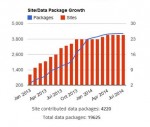Much has changed since the LTER Network Office (LNO) cooperative agreement was last renewed in 2009, but LNO staff continue to make progress toward the goals established in that award. Shortly after the National Science Foundation (NSF) renewed the LNO, additional funds from the American Recovery and Reinvestment Act (ARRA) allowed the LNO to support a series of key priorities for the LTER Network. These priorities included increased support for working groups and post-doctoral positions focused on cross-site synthesis, accelerated development of many elements of the Network Information System (NIS) including support for Information Management (IM) working groups and training, and an expanded program of communication and outreach. Products from these efforts include 57 synthesis projects, 20 IM projects, 12 training activities, and improved tools for communication and outreach including the new LTER annual report, revised web pages, an electronic newsletter, an improved LTER display, and training for LTER communication specialists.
More recently, a decrease in the LNO cooperative agreement of nearly a million dollars has limited our ability to continue some of these key activities. Nonetheless, we continue to facilitate LTER research through direct support of the Science Council and the All Scientists Meeting (ASM). Moreover, our efforts stimulate research by non-LTER scientists by facilitating open access to LTER data through the NIS.
The recent Science Council (SC) meeting began a project to analyze long-term changes in the regulation of primary production (see Scott Collins’ article in this newsletter). The LNO provided funding and organizational support for the meeting, and James Brunt from the LNO created an updated database of primary production at LTER sites. The LNO will document and archive derived datasets from the project in the NIS and will create workflows to update derived datasets dynamically. These efforts will increase the value of the work done by the SC by preserving both the derived data and the process behind those data. Future researchers will be able to draw on this archive for new analyses.
The number of LTER sites contributing data to the NIS and the number of data sets continue to increase (see accompanying graphic). LNO developers have just released an upgrade to the LTER Data Portal with additional features (https://portal.lternet.edu/nis/home.jsp). We have identified the first citation of a NIS-assigned Digital Object Identifier (DOI) from a paper by Thompson et al. (2013) from the Moorea Coral Reef site. Data in the NIS are now listed by DOI in the Web of Science Data Citation Index, allowing investigators to generate citation reports for their data sets. The best way to build your data citations is to cite your data in your own papers and get your colleagues to do the same. LTER data are being used for broad-scale analyses (e.g., Dornelas et al. (2014). Assemblage Time Series Reveal Biodiversity Change but Not Systematic Loss. Science 344: 296-299) by non-LTER researchers. Through efforts by James Brunt, Nature now recognizes the LTER NIS as a data repository that meets its requirements for archiving supporting data.
The NIS is based on a software framework called the Provenance Aware Synthesis Tracking Architecture (or PASTA) that addresses functional requirements identified by the LTER community. Recently, the LTER IM Committee identified a series of development tasks needed to make PASTA fully operational for data consumers. Unfortunately, NSF only partially supported a proposal from LNO to complete these tasks, meaning that several functions given high priority by the IM Committee cannot be addressed.
The cooperative agreement funding the LNO ends on April 30, 2015. Support to continue a coordinating office for the LTER Network will be provided through a new competition to be held in 2015. Conversations with NSF indicate that functions of the office may be divided between two calls for proposals, but details had not been finalized at press time. While plans for the future coordinating office unfold, the LNO will continue to operate as we have for the past 17 years, subject to the constraints of funding.
We will continue to interact closely with the Executive Board to identify and serve the needs of the LTER Network. The most important tasks we foresee are to follow up on the primary production project begun at the Science Council meeting, to carry out improvements to PASTA and the NIS as directed by NSF, and to prepare for the transition to a new model for Network coordination. Most exciting, we are looking forward to preparing for the 2015 ASM (see accompanying announcement). Funding to support meeting logistics has already been recommended, and the LNO is preparing another proposal to support site participants. We are well on the way to identifying members of a program committee, whose co-chairs will be Rich Bowden, Grizelle Gonzalez, and John Vande Castle. The next step will be to identify a meeting theme and begin to construct the agenda. As always, your ideas are welcome.

 Enlarge this image
Enlarge this image